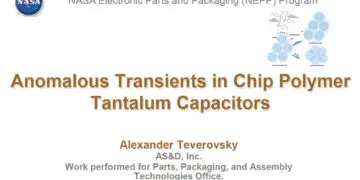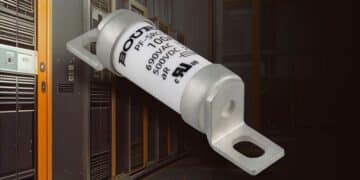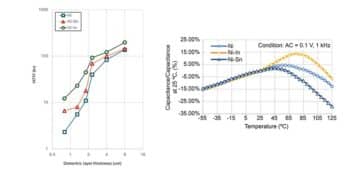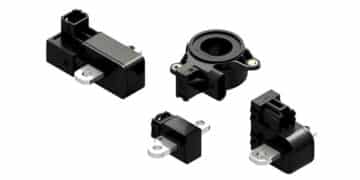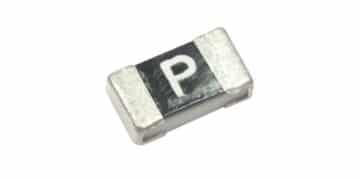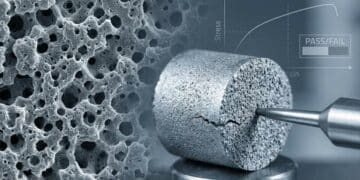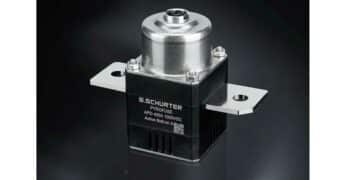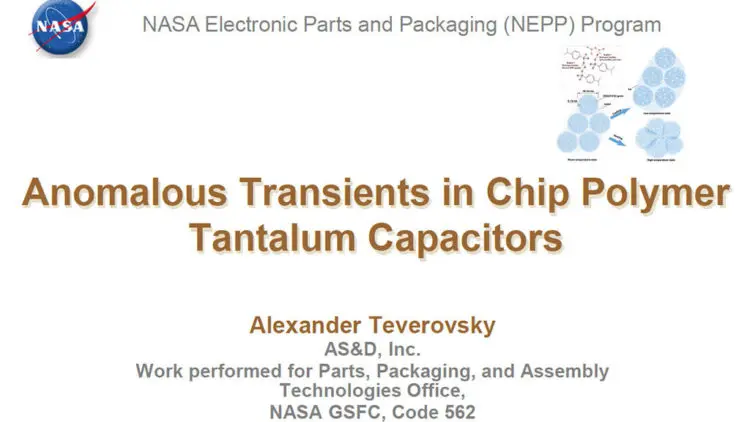source: AS&D, Inc. for NASA GSFC; ESA SPCD 2018 Symposium
EPCI e-symposium library article
Contrary to MnO2 tantalum capacitors, transient processes in polymer tantalum capacitors after voltage application might result in anomalously high, ampere-level currents when a capacitor might appear as a short circuit for a time that is much greater than a transient time in MnO2 capacitors.
In this work, conditions that cause anomalous transients in different types of polymer tantalum capacitors have been analyzed. Related phenomena that included increasing of capacitance and dissipation factors with voltage, parametric surge current test failures without damage to capacitors, and increasing leakage currents at low temperatures are described.
It has been shown that anomalous transients increased substantially with applied voltage and with reduction of moisture content in capacitors caused by storage or operation at high temperatures and/or in vacuum. Different types of capacitors exhibited different level of transients and modification of conductive polymers or process of their application might decrease transient leakage currents substantially.
For space applications, the risk of failures related to anomalous transients can be mitigated by special testing procedures to select parts with an acceptable level of transients and by voltage derating.
published by EPCI under approval of ESA SPCD 2018 organizing committee.
Title: Anomalous Transients in Chip Polymer Tantalum Capacitors
Author(s): Alexander Teverovsky (1)
Organisation(s): (1) AS&D, Inc. Work performed for Parts, Packaging, and Assembly Technologies Office, NASA GSFC, Code 562, USA
Symposium: ESA SPCD 2018
Reference: Test, Reliability & Evaluation for space 3.1.
ISBN: N/A
e-Sessions Applications: Aerospace
e-Sessions Scope Components: Capacitors
e-Sessions Topics: Quality & Reliability
Conductive Polymer Tantalum Capacitors (CPTC) Introduction
Major benefits compared to MnO2 capacitors:
- Better volumetric efficiency (smaller case sizes for the same CV);
- Higher operating voltages (up to 125V);
- Lower ESR (milliohm range);
- A relatively safe failure mode (no ignition).
Major drawbacks:
- Insufficient or excessive amount of moisture might be detrimental;
- Vacuum can be a benefit or a hazard;
- Weibull grading test is not applicable;
- ESR might degrade with time at high temperatures;
- A new phenomena: anomalous transients.
Anomalous transients include a group of phenomena:
- A temporary short circuit without damaging the part;
- Increasing of C and DF with voltage;
- Substantial increasing of DCL at low temperatures.
Experimental measurement set-up
Transient currents were monitored using three techniques:
- From 1 μsec to 1 msec using a current probe and an oscilloscope using a set-up for surge current testing.
- From 1 msec to 10 sec using a power SMU in Agilent Analyzer 4156A. The currents were clamped at 1 A at ≤ 20V and 0.5 A at ≤ 40V.
- From 10 sec to hours using a PC-based system by scanning voltages across 1k to 10k limiting resistors.
More than 20 types of CPTCs from three manufacturers rated from 6.3V to 35V were used. Most capacitors had case size D. The parts were used in “as is” (virgin) condition within a few
days of removal from dry bags, and after soaking in humidity chamber at 85 ºC, 85% RH (hum), or after storing at 125 ºC (bake). Duration of soaking or storing was typically 10 days. Thirteen part types were tested after 2000 hr storage in vacuum at 3×10-6 torr.
Effect of Preconditioning
Preconditioning: 7-10 days at 85C/85%RH or at 125C

- Preconditioning affects transient currents from 0.1 millisec to hours.
- Behavior of CPTCs with moisture is similar to MnO2 caps.
- At RT dry CPTCs might have currents >103times greater than humidified caps.
- Contrary to MnO2 capacitors, leakage currents at low temperatures in dry CPTCs might increase up to 106 times.
Effect of Temperature
Medium-term transients at -25, +20, and +85 ºC for different types of dry 35V and 6.3V capacitors

- Transient currents are increasing at low temperatures and might exceed 1A for up to 1 sec that might be interpreted as a short circuit failure during cold start-up of the system.
- Currents exceeding 1 A after 1 msecare currently considered a failure during surge current testing per MIL-PRF-55365.
- CPTCs with high-current transients can endure multiple surge cycling.
Effect of Voltage
Short and medium-term transients in 33 μF 35 V CPTCs after storage at 125 ºC, 100 msec currents in different 35 V capacitors.

- Near exponential I(V)dependence.
- The rate of voltage variations at low temperatures is changing at ~0.5VR
- At RT I(0.5VR)≈ 0.01×I(VR)
- Voltage deratingis an effective means to constrain anomalous transients.
Effect of Vacuum
Long-term transients were measured with time of storage in vacuum
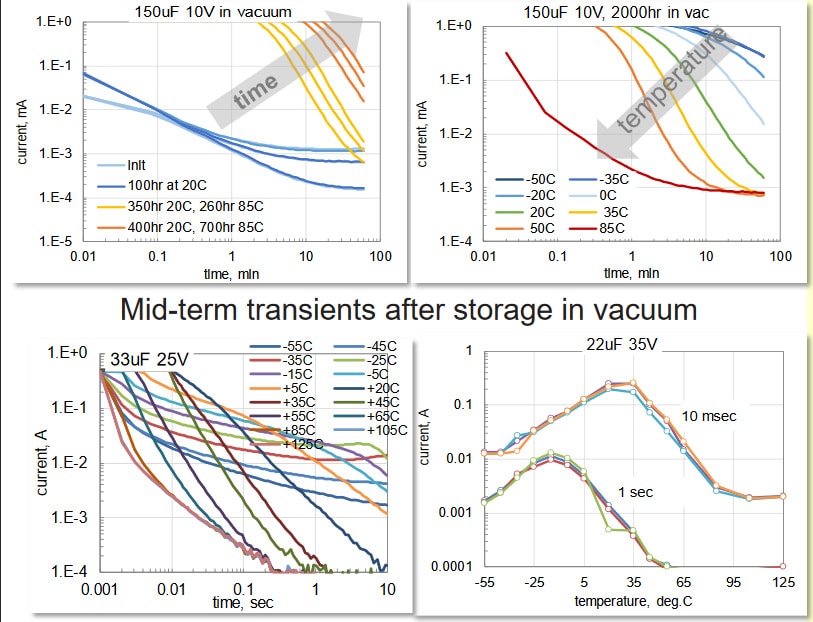
- Anomalous transients appear in vacuum after ~100hr.
- Currents might exceed 1 mA for more than 5 min.
- Inverse temp. dependence of leakage currents.
- Short-and long-term transients have different extreme dependencies on temperature and might be due to different mechanisms.
Operation at HALT under Bias

- Currents at RT after HALT during first few minutes exceeded currents at 165 ºC by orders of magnitude and then decreased more than 104 times after 10 hours.
- HT biased operation results in anomalies similar to HT storage
Effect of Part Type
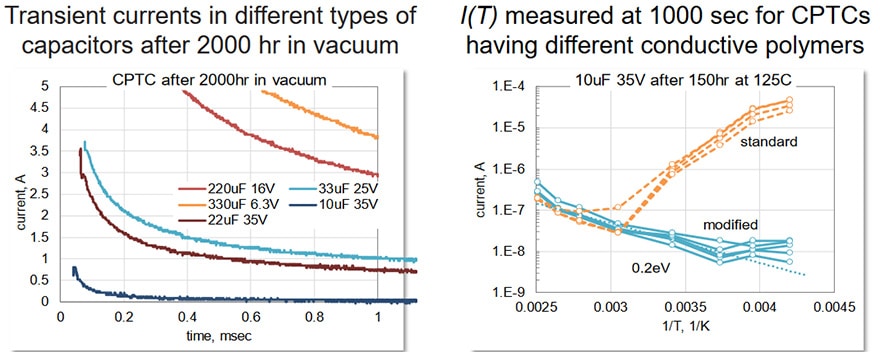
- After vacuum storage currents might exceed 3 A after 1 msec.
- Different part types have substantially different levels of transient currents.
- Modification of polymers can practically eliminate anomalies in behavior of CPTCs.
Anomalies in AC Characteristics
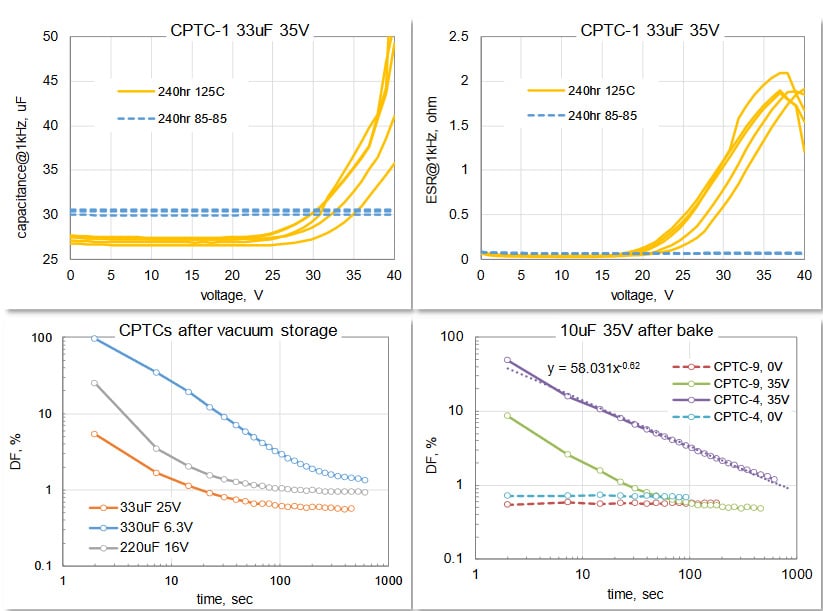
- In the presence of moisture AC characteristics are stable.
- C, ESR, and DF are increasing substantially with voltage.
- DF in dry CPTCs can increase well above 10% and then decrease gradually with time.
- Anomalous behavior is most evident at low frequencies and become negligible at f> 10 kHz.
DISCUSSION
Results of testing described above can be summarised as follows:
- Anomalous transients can occur in low-voltage that are typically using a hybrid technology, as well as in high-voltage polymer tantalum capacitors that might be manufactured using pre-polymerized PEDOT:PSS polymers only, and can be observed in a wide range of times, from milliseconds to hours. The major factor that affects transients is moisture content in polymers, which is consistent with works carried out by AVX [9] and KEMET [5]. More analysis is necessary to determine kinetics of moisture sorption and desorption in CPTCs at different temperatures. However, existing data indicate that substantial changes in the moisture content occur during baking for more than 100 hours at 125 ºC or by exposure to vacuum at relatively low temperatures (20 ºC to 85 ºC) for more than 1000 hours.
- No high currents during transients were observed in dry CPTCs at temperatures above ~ +65 ºC, but currents increased substantially (up to 6 orders of magnitude) at low temperatures, in the range from +20 ºC to -65 ºC. Temperature dependencies of transient currents have a maximum, position of which depends on moisture content and elapsed time under bias.
- CPTCs exhibiting anomalous transient currents have anomalies in AC characteristics measured under bias. In particular, application of rated voltage increased capacitance up to dozens of percent and DF or ESR up to 2 orders of magnitude. These variations were especially noticeable at relatively low frequencies (below 10 kHz) and similar to leakage currents, C and DF gradually decreased with time under bias.
- Different part types with similar ratings can have substantially different transient currents after drying. A proper selection of conductive polymers and processes of application can suppress anomalous transients substantially.
- Anomalous transient phenomena are observed in CPTCs only, and because MnO2 cathode capacitors do not exhibit these phenomena, the existing system of screening and qualification used for MnO2 military grade tantalum capacitors requires additional tests to constrain transients of DC and AC characteristics to the acceptable level.
Mechanism of Anomalies in C and DF
A simple C-R-r model of a capacitor with leakage can be used to explain the effect of voltage on C, ESR, and DF = ω×C×ESR


- The effect is due to increased conductivity of Ta2O5 that increases sharply with voltage.
Mechanism of Anomalous Transients
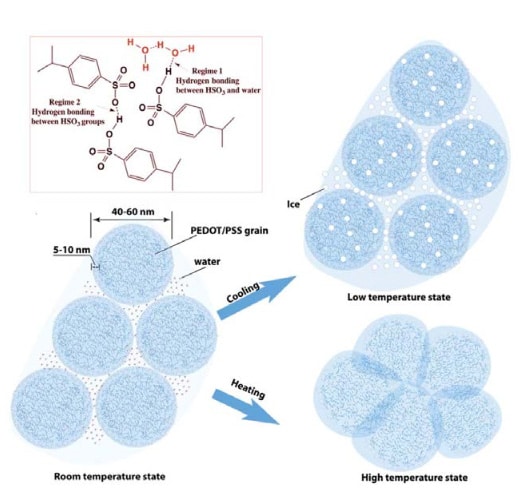
- The existing model for anomalous charging currents does not explain long-term transient effects.
- Variations in the moisture content and temperature affect the core-shell morphology of the polymer and might change its electronic band structure.
- Shifting positions of the molecular orbitals might change currents in CPTCs by changing the barrier height at the interface polymer/Ta2O5.
Changes in morphology of PEDOT/PSS with moisture content and temperature, Zhou et al. 2014
SUMMARY
- Anomalous transients in CPTCs after step voltage application include:
- Ampere-level currents for up to dozens of milliseconds resulting in a temporary shorting of the part. High dissipated power during transients results in temperature spiking that might create significant thermo-mechanical stresses in the slug and affect reliability of CPTCs.
- Anomalous temperature dependence of leakage currents measured after minutes of electrification when currents are increasing more than 3 to 4 orders of magnitude at low temperatures reaching maximum in the range from -10 ºC to -60 ºC.
- Increasing capacitance and ESR with voltage at low frequencies (below 10 kHz).
- A gradual relaxation of a dissipation factor measured under bias from more than 10% initially to below 1% after several minutes of electrification.
- Anomalous transients can be observed in low-voltage (rated to 6.3 V and 10 V) and high-voltage (>10 V) capacitors in dry conditions, e.g. after long-term exposure to vacuum or baking at 125 ºC for more than 100 hours. Moisture sorption, e.g. exposure to 85% RH at 85 ºC for a few days, practically eliminates anomalous transients and humidified CPTCs behave similar to MnO2 capacitors.
- The level of transients depends on the type of capacitors even for parts with the same rating. A proper selection of polymers as a cathode material and optimisation of application conditions might practically eliminate anomalies in behavior of CPTCs.
- The increase in conductivity of Ta2O5 dielectric in dry CPTCs is most likely due to structural changes in PEDOT:PSS polymers that are strongly affected by temperature and the moisture content. Both factors result in variations in the core-shell structure of the polymer and interactions between the grains that affect electronic structure of the polymer and the barrier height at the polymer/Ta2O5 interface. Injection of electrons and holes under bias might further change the barrier by oxidation/reduction reactions in the polymer resulting in a gradual decrease of leakage currents with time.
- Anomalies in behavior of AC characteristics are due to increased conductivity of the oxide during initial moments after step voltage application. This behavior can be explained using a simple C-R-r model of capacitors with leakage.
- Anomalous transients are most noticeable during sharp voltage rise and might not affect performance of CPTCs in applications when power turning-on occurs relatively slowly. Polymer tantalum capacitors can be used in space applications at the following conditions:
- circuit designers and parts engineers are aware of potential anomalies in behavior of CPTCs;
- 50% voltage derating is applied;
- the level of anomalous transients is limited by special screening and qualification procedures.
Recommendations
1. Surge current testing (SCT).
This test for MnO2 capacitors is used to reveal and screen-out weak parts that can fail short circuit. SCT for polymer capacitors should be used to select parts with the acceptable level of transient currents. The existing MIL-PRF-55365 requirements limiting maximum current after 1 msec can be used for CPTCs. The acceptance level can be set in the range from 0.5 to 1 A. As a part of gr. B testing, this test should be carried out at room and -55 ºC after baking of the parts (168 hours at 125 ºC).
2. Stability at low and high temperatures.
Leakage currents in MnO2 capacitors are decreasing substantially at low temperatures, and for this reason, DCL measurements at -55 ºC are not required. In dry CPTCs, leakage currents can increase orders of magnitude at low temperatures and for this reason, DCL should be measured at low temperatures after baking as a gr. B of testing. Considering that DCL can have maximum at temperatures lower than -55 ºC, additional measurements should be carried out at -25 ºC.
3. Biased AC characteristics.
Contrary to MnO2 parts, capacitance, and especially dissipation factor, in dry CPTCs can increase substantially with DC bias. Stability of C and DF should be controlled by delta analysis between 2.2 V and rated voltage. These measurements should be carried out as a gr.B test after baking. Acceptable lots should have ΔC/C0 < 20% and ΔDF/DF0 < 100%.
4. Qualification tests.
SCT and biased AC characteristics should be measured within 24 hours after life testing (following 1 hour depolarization) and after high temperature storage test (2000 hr at 125 ºC).
ACKNOWLEDGMENT
This work was sponsored by the NASA Electronic Parts and Packaging (NEPP) program. The author is thankful to Michael Sampson, NEPP Program Manager, for support of this investigation and discussions, Bruce Meinhold, ASRC Federal Space and Defense, Group Lead, for a review and recommendations.
REFERENCES.
[1] J. Ye, C. Stolarski, M. Yuan, and C. MotaCaetano. (2016). Conductive polymer based tantalum capacitors for automotive applications, KEMET. Available: https://ec.kemet.com/knowledge/detailed-data-for-automotive-polymer-capacitors
[2] M. Weaver, “Attributes and Challenges of Polymer Electrolytic Capacitors in High Reliability Applications, AVX ” in Components for Military and Space Electronics, CMSE’18, Los Angeles, CA, 2018, pp. 3-2.
[3] J. Young, “Polymer Tantalum Capacitors for Automotive Applications,” in CARTS International, Santa Clara, CA, 2014, pp. 297-311.
[4] A. Teverovsky, “Evaluation of 10V chip polymer tantalum capacitors for space applications,” presented at the ESA 2nd International Symposium – Space Passive Component Days, Noordwijk, The Netherlands, 2016.
[5] Y. Freeman, G. F. Alapatt, W. R. Harrell, I. Luzinov, P. Lessner, and J. Qazi, “Anomalous Currents in Low Voltage Polymer Tantalum Capacitors,” Ecs Journal of Solid State Science and Technology, vol. 2, pp. N197-N204, 2013.
[6] A. Teverovsky, “Leakage currents and gas generation in advanced wet tantalum capacitors,” NASA/GSFC, Greenbelt, MD, 2015.
[7] A. Teverovsky, “Insulation Resistance and Leakage Currents in Low-Voltage Ceramic Capacitors With Cracks,” Components, Packaging and Manufacturing Technology, IEEE Transactions on, vol. 4, pp. 1169-1176, 2014.
[8] A. Teverovsky, “Degradation of leakage currents in solid tantalum capacitors under steady-state bias conditions,” in Electronic Components and Technology Conference (ECTC), 2010 Proceedings 60th, 2010, pp. 752-757.
[9] J. Petrzilek, M. Biler, and T. Zednicek, “Hermetically Sealed Conductive Polymer Tantalum Capacitors,” in CARTS International, Santa Clara, CA, 2014, pp. 287-292.
[10] J. Zhou, D. H. Anjum, L. Chen, X. Z. Xu, I. A. Ventura, L. Jiang, et al., “The temperature-dependent microstructure of PEDOT/PSS films: insights from morphological, mechanical and electrical analyses,” Journal of Materials Chemistry C, vol. 2, pp. 9903-9910, 2014.
[11] A. M. Nardes, M. Kemerink, M. M. de Kok, E. Vinken, K. Maturova, and R. A. J. Janssen, “Conductivity, work function, and environmental stability of PEDOT : PSS thin films treated with sorbitol,” Organic Electronics, vol. 9, pp. 727-734, Oct 2008.
[12] U. Lang, N. Naujoks, and J. Dual, “Mechanical characterization of PEDOT:PSS thin films,” Synthetic Metals, vol. 159, pp. 473-479, 3// 2009.
[13] H. Okuzaki, K. Hosaka, H. Suzuki, and T. Ito, “Electrically driven PEDOT/PSS actuators,” 2010, pp. 76422U-76422U-8.
[14] S. Demtchenko, N. G. Tarr, and S. McGarry, “Effect of PEDOT band structure on conductive polymer-insulator-silicon junctions,” Journal of Applied Physics, vol. 122, p. 065502, 2017.
[15] L. M. Y. Yang, J. Ouyang, J. He, H. M. Liem, C.-W. Chu, A. Prakash, “Organic Nonvolatile Memories,” in Materials for Information Technology : Devices, Interconnects and Packaging, C. W. a. T. M. E. Zschech, Ed., ed: Springer, 2006.
[16] S. Smith and S. R. Forrest, “A low switching voltage organic-on-inorganic heterojunction memory element utilizing a conductive polymer fuse on a doped silicon substrate,” Applied Physics Letters, vol. 84, pp. 5019-5021, Jun 2004.
see the presentation pdf link here:![]()
